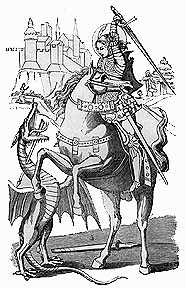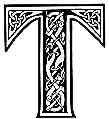
St. George; or how George, a tribune in the Roman army, came to Selene in Libya where a terrible dragon was eating several children a day and otherwise ravaging the land; and how just as George arrived it came time for the princess Cleodolinda to be sacrificed; and how George saved her, but later was tortured cruelly and put to death by the Romans because of his faith...
Patron saint of armourers and soldiers. ( April 23, A.D. 303)
 he legend of St. George, as it was accepted by the people and artists of the middle ages, runs thus:--He was a native of Cappadocia, living in the time of the Emperor Diocletian, born of noble Christian parents, and a tribune in the army. It is related that in traveling. to join his legion he came to a certain city in Libya called Selene. The inhabitants of this city mere in great trouble and consternation in consequence of the ravages of a monstrous dragon, which issued from a neighboring lake or marsh, and devoured the flocks and herds of the people, who had taken refuge within the walls: and to prevent him from approaching the city, the air of which was poisoned by his pestiferous breath, they offered him daily two sheep; and when the sheep were exhausted, they were forced to sacrifice to him two of their children daily, to save the rest. The children were taken by lot (all under the age of fifteen); and the whole city was filled with mourning, with the lamentations of bereaved parents and the cries of the innocent victims.
he legend of St. George, as it was accepted by the people and artists of the middle ages, runs thus:--He was a native of Cappadocia, living in the time of the Emperor Diocletian, born of noble Christian parents, and a tribune in the army. It is related that in traveling. to join his legion he came to a certain city in Libya called Selene. The inhabitants of this city mere in great trouble and consternation in consequence of the ravages of a monstrous dragon, which issued from a neighboring lake or marsh, and devoured the flocks and herds of the people, who had taken refuge within the walls: and to prevent him from approaching the city, the air of which was poisoned by his pestiferous breath, they offered him daily two sheep; and when the sheep were exhausted, they were forced to sacrifice to him two of their children daily, to save the rest. The children were taken by lot (all under the age of fifteen); and the whole city was filled with mourning, with the lamentations of bereaved parents and the cries of the innocent victims.
Now the living of this city had one daughter, exceedingly fair, and her name was Cleodolinda. And after some time, when many people had perished, the lot fell upon her, and the monarch, in his despair, offered all his gold and treasures, and even the half of his kingdom, to redeem her; but the people murmured, saying, is this just, O King! that thou, by thine own edict, hast made us desolate, and, behold, now thou wouldst withhold thine own child?'--and they waxed more and more wroth, and they threatened to burn him in his palace unless the princess was delivered up. Then the king submitted, and asked only a delay of eight days to bewail her fate, which was granted; and at the end of eight days, the princess, being clothed in her royal robes, was led forth as a victim for sacrifice; and she fell at her father's feet and asked his blessing, saying that she was ready to die for her people: and then, amid tears and lamentations, she was put forth, and the gates shut against her. Slowly she walked towards the dwelling of the dragon, the path being drearily strewn with the bones of former victims, and she wept as she went on her way. Now, at this time, St. George was passing by, mounted on his good steed; and, being moved to see so beautiful a virgin in tears, he paused to ask her why she wept, and she told him, and he said, 'Fear not, for I will deliver you and she replied, 'O noble youth, tarry not here, lest thou perish with me! but fly, I beseech thee.' But St. George would not; and he said, 'God forbid that I should fly! I will lift my hand against this loathly thing, and will deliver thee through the power of Jesus Christ!'
At that moment the monster was seen emerging from his lair, and half-crawling, half-flying towards them. Then the virgin princess trembled exceedingly, and cried out, 'Fly, I beseech thee, brave knight, and leave me here to die!' But he answered not; only making the sign of the cross and calling on the name of the Redeemer, he spurred towards the dragon, and, after a terrible and prolonged combat, he pinned him to the earth with his lance. Then he desired the princess to bring her girdle; and he bound the dragon fast, and gave the girdle to her hand, and the subdued monster crawled after them like a dog. In this guise they approached the city. The people being greatly terrified, St. George called out to them, saying,--'Fear nothing; only believe in the God through whose might I have conquered this adversary, and be baptized, and I will destroy him before your eyes.' So the king and his people believed, and were baptized,--twenty thousand people in one day. Then St. George slew the dragon and cut off his head; and the king bestowed great rewards and treasures on the victorious knight; but he distributed all to the poor, and kept nothing, and went on his way and came to Palestine.
At that time the edict of the Emperor Diocletian against the Christians was published, and it was affixed to the gates of the temples and in the public markets; and men read it with terror, and hid their faces; but St. George, when he saw it, was filled with indignation, the spirit of courage from on high came upon him, and he tore it down, and trampled it under his feet. Whereupon he was seized, and carried before Dacian the proconsul, and condemned to suffer during eight days the most cruel tortures. First they bound him on a wooden cross and tore his body with sharp iron nails, and then they scorched and burned him with torches, and rubbed salt into his smarting wounds. And when Dacian saw that St. George was not to be vanquished by torments, he called to his aid a certain enchanter, who, after invoking his demons, mingled strong poison with a cup of wine and presented it to the saint. He, having made the sign of the cross and recommended himself to God, drank it off without injury:--(an impressive allegory, signifying the power of Christian truth to dispel and defeat evil). When the magician saw this miracle, he fell at the feet of the saint, and declared himself a Christian. Immediately the wicked judge caused the enchanter to be beheaded; and St. George was bound upon a wheel full of sharp blades; but the wheel was broken by two angels who descended from heaven. Thereupon they flung him into a cauldron of boiling lead: and when they believed that they had subdued him by the force of torments, they brought him to the temple to assist at the sacrifice, and the people ran in crowds to behold his humiliation, and the priests mocked him. But St. George knelt down and prayed, and thunder and lightning from heaven fell upon the temple, and destroyed it and the idols; and the priests and many people were crushed beneath the ruins, as at the prayer of the son of Manoah in ancient times. Then Dacian, seized with rage and terror, commanded that the Christian knight should be beheaded. He bent his neck to the sword of the executioner, and received bravely and thankfully the stroke of death.
Source: Summary, LDL; Narrative, Anna Jameson (Sacred and Legendary Art)